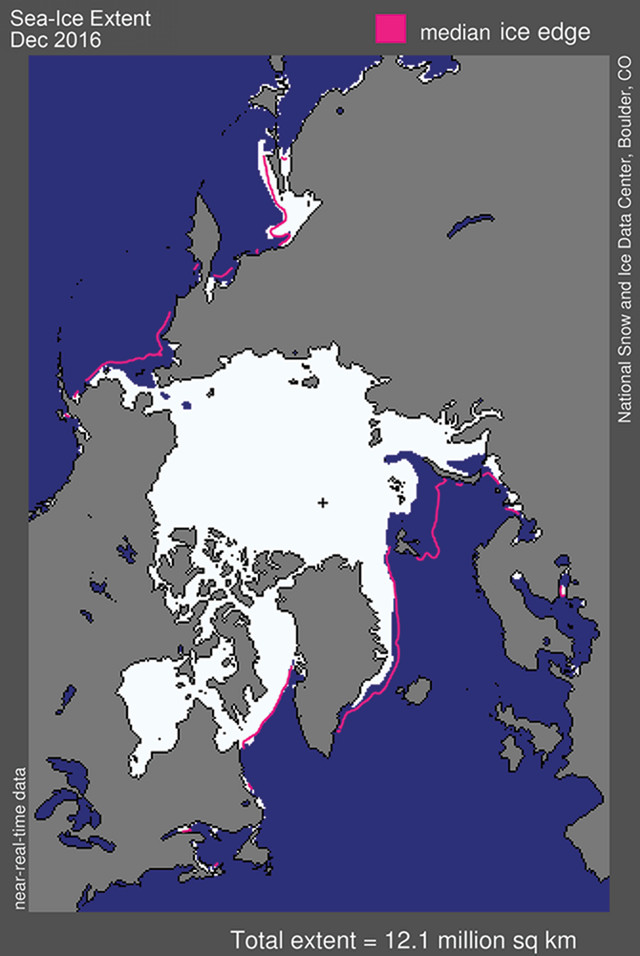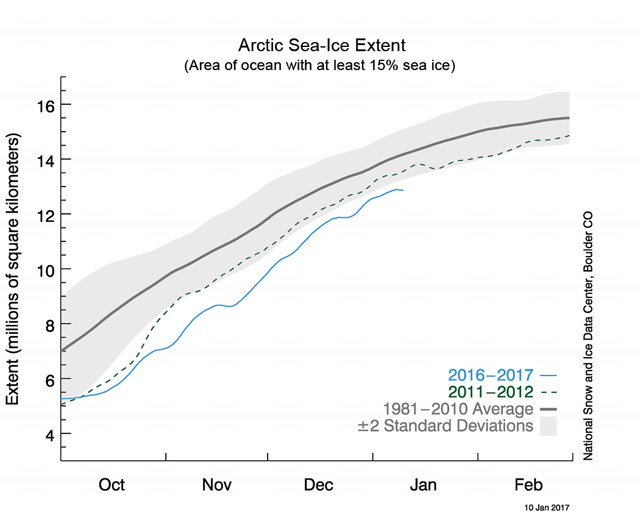
by Mark C. Serreze Monday, January 23, 2017

The Arctic sea-ice extent for December 2016 was 12.10 million square kilometers — a record low for this time of year. The magenta line shows the 1981 to 2010 median extent for December. The black cross indicates the geographic North Pole. On Dec. 22, weather models showed temperatures near the North Pole about 17 to 22 degrees Celsius above average. Credit: NSIDC.
I have studied the climate of the Arctic since the early 1980s. In that time, I’ve had a front row seat from which to observe the radical transformation of the region as I’ve been involved in research on the Arctic’s atmosphere, sea ice, ocean circulation, snow cover, permafrost and hydrologic cycle. For more than a century, it has been recognized that, as atmospheric greenhouse gases increase globally, the resulting warming and its effects would be most pronounced in the Arctic. These predictions have been realized: Over the past several decades, the Arctic has warmed at roughly twice the rate as the rest of the planet. And the Arctic Ocean’s sea-ice cover, which waxes and wanes with the seasons, growing through autumn and winter and shrinking through spring and summer, has gradually shrunk.
Sea-ice extents are declining for all months, but as assessed over the period of satellite observations (1979 to present), the extent at the end of the melt season in September is dropping at the remarkable rate of 13 percent per decade (relative to the average September extent from 1981 to 2010). Permafrost is also warming and, in some areas, thawing. Areas of treeless, windswept tundra are being taken over by shrubs. And the Greenland Ice Sheet is melting at an accelerating rate, contributing to rising sea levels. But through all of my time studying the Arctic, never have I seen anything like the events of the last year.
To start, in the winter of 2015–2016, an unprecedented heat wave occurred over the Arctic Ocean. At the end of December 2015, there was a brief period when the surface air temperature at the North Pole appears to have actually risen to above freezing. Late December temperatures at the North Pole at or above zero degrees Celsius are unheard of in the climate record. The heat wave persisted, slowing the wintertime growth of sea ice and, on March 24, when Arctic sea ice reached its seasonal maximum extent, it was the lowest maximum ever recorded, breaking the previous record set just a year earlier in 2015.

Measurements of sea-ice extent are collected daily. The gray curve in this time series indicates the average sea-ice extent for October through February from 1981 to 2010, with the two-standard-deviation uncertainty represented by the shaded area. The blue curve indicates measurements for the current season through Jan. 10, while the dashed green curve representing 2011–2012 is shown for comparison. Credit: NSIDC.
With much less ice than normal at winter’s end, the melt season started out on a bad foot, leading to speculation that the following September would also see a new record low. As it turned out, the seasonal minimum extent, which occurred on Sept. 10, ended up as only the second lowest on record, largely because of the remarkably stormy conditions that occurred during the summer, including a pair of tremendously strong and deep low-pressure systems in August. Strong low-pressure systems have a tendency to chew up the ice cover, but they also tend to spread sea ice out over a larger area and bring cloudy and relatively cool conditions with them that inhibit melting. The summer of 2016 was the stormiest summer over the central Arctic Ocean in my experience.
After the Sept. 10 seasonal minimum, the sea ice started its annual pattern of growth, but then another heat wave — even more impressive than the one seen the previous winter — moved in over the Arctic Ocean. In autumn, the Arctic is usually cooling rapidly and sea ice is growing quickly, but both October and November saw record lows in ice extent for those months. There was even a brief period in the middle of November when ice extent actually declined. As I wrote the first draft of this column on Dec. 22, a day after the winter solstice, the Arctic Ocean heat wave was continuing, with the weather models showing temperatures near the North Pole about 17 to 22 degrees Celsius above average. Sea-ice extent continues to track at record low levels for this time of year.
What the heck is happening? By any measure, the heat wave of the winter of 2015–2016, as well as what we’ve seen this past fall and early winter, represent extreme events. I’d argue that last summer’s excessive storminess also represents an extreme, albeit one that probably prevented yet another record-low September sea-ice extent. As any climate scientist will be quick to point out, it is never wise to read too much into individual extreme events — they happen. And there are identifiable causes for the events. Stormy summers tend to bring cool conditions over the Arctic Ocean, and both of the recent autumn/winter heat waves could be related to unusual patterns of atmospheric circulation drawing tremendous amounts of heat into the Arctic Ocean. There has also been a recent shift in ocean circulation, with more warm water from the Atlantic being brought into the Arctic; these warm ocean waters prevent sea-ice formation and warm the overlying air.
One could argue that these events are just expressions of natural variability in Arctic climate superimposed upon the overall pattern of warming and sea-ice loss. But changes in extreme weather and climatic events in recent years have been well documented around the world. Heat waves have tended to be hotter, and a warmer atmosphere can hold more water vapor, raising prospects for excessive precipitation. Random extreme events have always been a part of the climate system, but by loading the atmosphere with greenhouse gases, we’ve also loaded the dice. Are the recent events in the Arctic examples of what we’ll be seeing more of in the near future? Time will tell. But after studying the Arctic and its climate for three and a half decades, I have concluded that what has happened over the last year goes beyond even the extreme.
© 2008-2021. All rights reserved. Any copying, redistribution or retransmission of any of the contents of this service without the expressed written permission of the American Geosciences Institute is expressly prohibited. Click here for all copyright requests.